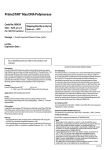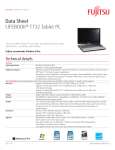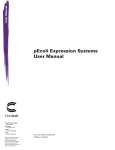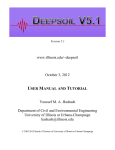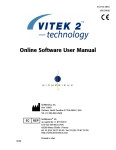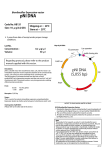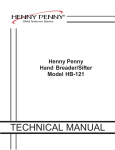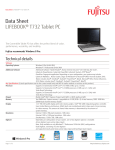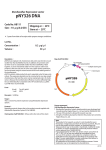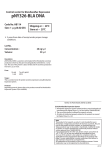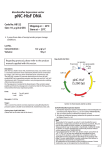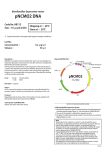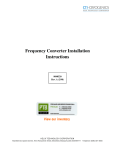Download Cat. # HB131 and HB132
Transcript
Cat. # HB131/HB132 For Research Use Brevibacillus Expression System Intracellular Expression Vectors pNI DNA (Cat. #HB131) pNI-His DNA (Cat. #HB132) Product Manual v201509 Brevibacillus Expression System Intracellular Expression Vectors Cat. #HB131/HB132 v201509 Table of Contents 2 I. Introduction...................................................................................................... 3 II. Components..................................................................................................... 3 III. Storage................................................................................................................ 3 IV. Overview of Intracellular Expression Vectors....................................... 4 V. Protocol............................................................................................................... 7 VI. Experimental Example................................................................................14 VII. Related Products...........................................................................................16 VIII. References........................................................................................................16 URL:http://www.takara-bio.com Brevibacillus Expression System Intracellular Expression Vectors Cat. #HB131/HB132 v201509 I. Introduction Brevibacillus (Bacillus brevis ) Expression System is a high-efficiency protein production system. This gram-positive bacterium is characterized by its ability to secrete/produce large amount of proteins1). This characteristic has been successfully used for secretory production of a large number of heterologous proteins. Recent studies have shown that this bacterium is also capable of intracellular protein expression. Proteins that are insoluble and precipitate when produced in E. coli can be recovered in a soluble state when produced by this bacterium. This system is recommended for the production of functional proteins that are endogenously produced intracellularly but are insoluble and cannot undergo in vitro refolding when produced in E. coli . This system has the following features: ・Efficient intracellular production of soluble heterologous proteins ・Simple procedures for genetic manipulation and culturing ・Almost no detectable protease activity ・Production of active protein ・Safe host bacteria Using an E. coli-Brevibacillus shuttle vector, expression vectors can be constructed in E. coli . A vector with a his-tag inserted at the N-terminus that allows target protein purification using a nickel purification column is also available. The his-tag can be removed by treating the purified protein with enterokinase. II. Component pNI DNA (Cat. #HB131) pNI-His DNA (Cat. #HB132) 【 Form 】 10 μg (0.2 μg/μl) 10 μg (0.2 μg/μl) 10 mM Tris-HCl, pH 8.0 1 mM EDTA III. Storage -20℃ *2 years from date of receipt under proper storage conditions. URL:http://www.takara-bio.com 3 Brevibacillus Expression System Intracellular Expression Vectors Cat. #HB131/HB132 v201509 IV. Overview of Intracellular Expression Vectors The workflow to produce target proteins using this system is described below. IV-1. Selection of expression vectors (1) pNI DNA pNI DNA is an intracellular expression vector constructed by removing the secretory signal segment from the secretory expression vector pNCMO2 DNA (Cat. #HB112) to allow intracellular accumulation of expressed proteins. The rest of its sequence is the same as pNCMO2 DNA. It is a shuttle vector between Brevibacillus and E. coli ; the target gene is cloned into the vector in E. coli , and then the plasmid is transferred to Brevibacillus for protein expression. pNI DNA uses the P2 promoter from the Brevibacillus host cell wall protein as promoter for expression of the target gene. The P2 promoter exhibits weak activity in E. coli and is useful for cloning target genes. It is a very strong promoter in Brevibacillus and is suitable for efficient protein production in Brevibacillus . (2) pNI-His DNA pNI-His DNA is an intracellular expression vector containing a his-tag sequence (6 x His) and an enterokinase recognition sequence for tag removal. This vector allows for easy purification of expressed proteins using nickel chelate resin. The rest of its sequence is the same as pNI DNA. P2 promoter Lac operator − multi cloning site + ColE1 pNI DNA pNI DNA: 5,055 bp pNI-His DNA: 5,079 bp Figure 1. Vector Map of pNI DNA 4 URL:http://www.takara-bio.com Brevibacillus Expression System Intracellular Expression Vectors Cat. #HB131/HB132 v201509 <Features of pNI and pNI-His DNA> P2 promoter A portion of 5' sequence upstream of the cell wall protein (HWP) gene, which is expressed strongly in Brevibacillus His-tag + enterokinase pNI-His DNA only recognition sequence Multiple cloning site 12 restriction enzyme cleavage sites (pNI DNA) 10 restriction enzyme cleavage sites (pNI-His DNA) Terminator A 46-bp termination signal inserted downstream from the multiple cloning site. rep Gene involved in plasmid replication (derived from pUB110) Ori Replication origin allowing replication and maintenance of the plasmid in Brevibacillus (derived from pUB110) Nm r Neomycin resistance gene, selection marker in Brevibacillus ColE1 ori Replication origin allowing replication and maintenance of the plasmid in E. coli (derived from pUC). Amp r Ampicillin resistance gene, selection marker in E. coli URL:http://www.takara-bio.com 5 Brevibacillus Expression System Intracellular Expression Vectors Cat. #HB131/HB132 v201509 < Cloning Sites of pNI DNA > AAGGCGCCGCAACTTTTGATTCGCTCAGGCGTTTAATAGGATGTAATTGTGAGCGGATAA 120 P2-35 P2-10 operator I I CAATTATTCTGCATGGCTTTCCTGCGAAAGGAGGTGACACGCGCCATGGCTTTCGCTGCA 180 Start codon SD1 Cloning site HI I I I RI I I BI I d III GGATCCGTCGACTCTAGACTCGAGGAATTCGGTACCCCGGGTTCGAAATCGATAAGCTTC 240 GGCATTATAG < Cloning Sites of pNI-His DNA > AAGGCGCCGCAACTTTTGATTCGCTCAGGCGTTTAATAGGATGTAATTGTGAGCGGATAA 120 P2-35 P2-10 operator I CAATTATTCTGCATGGCTTTCCTGCGAAAGGAGGTGACACGCGCCATGGCTCACCATCAC 180 SD1 M A H H H His-Tag Cloning site HI I I I RI I CATCACCATGATGACGATGACAAAGGATCCGTCGACTCTAGACTCGAGGAATTCGGTACC 240 H H H D D D D K Enterokinase I BI I d III CCGGGTTCGAAATCGATAAGCTTCGGCATTATAG 6 URL:http://www.takara-bio.com Brevibacillus Expression System Intracellular Expression Vectors Cat. #HB131/HB132 v201509 IV-2. Cloning into expression vectors For pNI DNA, the gene of interest is inserted into the multiple cloning site (MCS). If the Nco I site is usable, extra amino acids derived from the MCS will not be included in the resulting protein. Using a restriction site other than Nco I will result in the addition of extra amino acids to the N-terminus, depending on the site. For pNI-His DNA, the gene of interest is inserted into a site downstream of Bam H I. IV-3. Transformation of Brevibacillus Transformation of B. choshinensis cells can be performed using the New Tris-PEG (NTP) method (Section V-4). The selection marker is neomycin resistance. When the shuttle vector is used in combination with E. coli host, ampicillin resistance can be used as the selection marker in E. coli . IV-4. Detection of protein production and scale-up Culture a negative control concurrently to confirm the expression of the target protein. Culture transformants harboring the target protein expression plasmid in the specified liquid medium with shaking for 48 to 64 hours to express the target protein. The bacterial cultures will be used for to SDS-PAGE analysis, or a similar test, to confirm the presence/absence of protein expression. Scale up the culture volume when a large amount of product is required. V. Protocol V-1. Brevibacillus strain Standard genetic engineering techniques are applicable. V-1-1. Genotype Because genes relating to sporulation have been disrupted, it is easy to perform sterilization of the strain. Additionally, disruption of the intracellular protease gene (imp) and extracellular protease gene (emp) minimizes degradation of expressed recombinant proteins. V-1-2. Storage of recombinant Brevibacillus Short-term storage (about 1 week) 1. Pick a single colony and spread on a MTNm plate. 2. Place the plate in an incubator at 30℃ overnight. 3. Seal the plate and store it at room temperature (about 20℃). Note: Do not store the plates in a refrigerator. Long-term storage (1 month or longer) 1. Pick a single colony and inoculate into 2SYNm medium (see V-8. Medium components). Culture overnight on a shaker. 2. Transfer the broth to a freezing vial and add an equal amount of LB medium containing 40% glycerol. 3. Store at -80℃. 4. Thaw each vial immediately before use and inoculate at 0.1 - 1.0% volume of liquid medium. Note: Do not subject cell stocks to repeated freeze-thaw cycles. URL:http://www.takara-bio.com 7 Brevibacillus Expression System Intracellular Expression Vectors Cat. #HB131/HB132 v201509 V-2. E. coli host A lac operator is inserted in pNI DNA and pNI-His DNA to weaken the promoter activity in E. coli . For that reason, JM109 or another F factor integrated strain inserted with an F factor (laclq ) must be used. The genotype of JM109 is shown below for reference. JM109: recA1 , endA1, gyrA96, hsdR17 , thi-1, hsdR17 (rK- mK+), e14 - (mcrA - ), supE44, relA1 , △ (lac-proAB ) /F’ [ traD36, proAB+, lac Iq, lacZ △ M15 ] V-3. Construction of an expression plasmid using pNI DNA and pNI-His DNA Precautions for the construction of expression plasmids using pNI DNA and pNI-His DNA E. coli strains containing lac lq and recA -, such asn JM109, are recommended as the host for plasmid construction. Insert DNA should be cloned in-frame, downstream from the tag sequence. Insert a stop codon at the end of the target gene to be cloned. V-3-1. Cloning insert DNA into pNI DNA or pNI-His DNA < Gene amplification using PCR > Design PCR primers so that the target gene is inserted downstream of the tag sequence. Introduce two types of restriction enzyme sites at the ends of the PCR product to establish directionality. Amplify the target gene by PCR. Select PCR conditions based on the primers and PCR enzyme used in the reaction. The use of a high-fidelity PCR enzyme, such as PrimeSTAR® Max DNA Polymerase (Cat. #R045A), is recommended. < Construction of the expression plasmids through ligation > Select two restriction enzyme sites in the expression vector multiple cloning site that match both ends of the target DNA insert to establish directionality. Treat 0.5 - 1.0 μg of the insert and vector DNA with the restriction enzymes. Perform agarose gel electrophoresis on both the vector and insert DNA restriction enzyme reactions, then collect and purify the target fragments. Ligate - 100 ng of each purified DNA fragment using a ligation reagent such as DNA Ligation Kit <Mighty Mix> (Cat. #6023). Use a portion of the reaction solution for transformation of E. coli . < Cloning with In-Fusion® Cloning System > The In-Fusion HD Cloning Kit can be used to simply and quickly carry out directional cloning even when there are no appropriate restriction enzyme sites. Refer to the In-Fusion Cloning System protocol. < Transformation of E. coli > Use an E. coli host with high transformation efficiency. E. coli JM109 Competent Cells (Cat. #9052)* or E. coli JM109 Electro-Cells (Cat. #9022)* are recommended. *: Not available in all geographic locations. Check for availability in your region. 8 URL:http://www.takara-bio.com Brevibacillus Expression System Intracellular Expression Vectors Cat. #HB131/HB132 v201509 V-3-2. Analysis of recombinants After spreading 100 - 200 μl of the transformation mixture onto LB plates containing 50 - 100 μg/ml ampicillin, incubate the plates at 37℃ for 15 - 18 hours. Select 10 - 20 ampicillin-resistant colonies and inoculate into 2 ml of LB liquid medium containing 50 - 100 μg/ml ampicillin. Grow for 15 - 18 hours at 37℃ with shaking and isolate plasmid DNA. Perform restriction enzyme analysis using an appropriate amount of DNA. Usually the same enzymes that were used for the construction of the expression plasmid are used. After confirming the presence of the insert, perform sequencing to confirm that the gene contains no PCR-introduced errors and is in-frame with tag-sequence in pNI-His. V-3-3. Sequencing The following forward and reverse primers can be used to confirm the insert DNA sequence. (Primer sequences are shared by pNI DNA and pNI-His). Forward Sequencing Primer: 5’-TCGAAGGCGCCGCAAC- 3’ Reverse Sequencing Primer: 5’-CAATGTAATTGTTCCCTACCTGC- 3’ V-4. Transformation of Brevibacillus V-4-1. Preparation Brevibacillus Competent Cells (Cat. #HB116) (Contents) Brevibacillus Competent Cells MT medium Solution A Solution B Plasmid for target gene expression Plasmid for negative control (blank vector) MTNm plates* Culture tubes Sterilized microtubes *: Refer to V-8. Medium Components URL:http://www.takara-bio.com 9 Brevibacillus Expression System Intracellular Expression Vectors Cat. #HB131/HB132 v201509 V-4-2. NTP Transformation Method (1) Thaw Solution A, Solution B, and MT medium. (2) Remove only the number of tubes of Brevibacillus Competent Cells needed for transformation from storage, and keep on dry ice/ethanol. (3) Thaw the Brevibacillus Competent Cells quickly (approximately 30 sec.) in a 37℃ water bath. (4) Centrifuge the cells (12,000 rpm for 30 sec. to 1 min.) to form a cell pellet and remove the supernatant with a micropipette. Perform the following procedures at room temperature. (5) Mix the plasmid DNA solution (in a volume of 5 μl or less)*1 with 50 μl of Solution A. (6) Add all of the DNA solution to the bacterial cell pellet (from step 4) and vortex to completely suspend the bacterial pellet.*2 (7) Allow to stand for 5 minutes at room temperature. (8) Add 150 μl of Solution B (PEG solution)*3 and vortex until the solution is uniform (5 - 10 sec.). (9) Centrifuge the cells (5,000 rpm for 5 min.) and remove the supernatant. (10) Centrifuge briefly (5,000 rpm for 30 sec.) and remove the supernatant completely. (11) Add 1 ml of MT medium and suspend completely with a micropipette. (12) Incubate at 37℃ in an orbital shaker (120 rpm for 2 hours). (13) Use a sterile inoculating loop to remove a small sample from the culture. Streak on the MTNm plates and culture overnight at 37℃. (14) Select isolated colonies for plasmid analysis or protein expression. *1: When DNA ligation solution is used, mix 5 μl of the reaction solution with Solution A. When using purified plasmids, use 10 - 100 ng. *2: Be sure to suspend well, as incomplete dispersion of cells will decrease the efficiency of transformation. *3: Solution B (PEG solution) is highly viscous-use a 1,000 μl micropipette and pipette slowly. V-5. Target proteins expression with recombinant Brevibacillus After the construction of expression strain is complete, perform a small-scale protein expression analysis. A standard protocol for verifying expression is given here. V-5-1. Overview After a positive clone has been identified, check expression together with a negative control. The production of the target protein may vary among transformants depending on the nature of the protein. The size of colonies may also vary. Thus, six to ten colonies should be selected at random (including both large and small colonies) for culturing in test tubes. If the plates are left for several days after transformation, protein production may be decreased. If this occurs, repeat the transformation. 10 URL:http://www.takara-bio.com Brevibacillus Expression System Intracellular Expression Vectors Cat. #HB131/HB132 v201509 V-5-2. Culture media Use 2SYF medium as a basic medium for expression analysis. V-5-3. Culture for protein production By growing cultures of a transformant expressing the target protein and a negative control, expression of a target protein can be confirmed. The protocol for expression analysis is shown below. (1) Select individual colonies and inoculate into 3 ml 2SYFNm liquid medium in culture tubes (ϕ16 mm). Incubate at 30 - 33℃ with shaking at 120 rpm for 48 - 64 hours. Perform sampling every 24 hours to check target protein production. (2) At the end of incubation, isolate the cells by centrifugation at 5,000 X g for 5 minutes. (3) Suspend the cells in PBS*1 and sonicate to disrupt the cells*2. Make sure to perform this step in an ice bath to avoid increases in temperature. (4) Separate the supernatant and precipitate in the cell homogenate by centrifugation at 20,000 X g for 10 minutes. Suspend the precipitate in a volume of PBS equal to the volume of the supernatant. (5) Evaluate protein expression in the pellet fraction using SDS-PAGE (CBB staining or Western blotting) or measure protein activity. *1: Can be prepared using PBS Tablets (Cat. #T900). *2: The standard sonication conditions when using a BRANSON SONIFIER 350 are 50% duty, output 4 to 5, and 30 seconds x 2. Select the optimal conditions when using a different device. V-6. SDS-PAGE analysis Use an SDS-PAGE gel suitable for isolating the target protein. V-6-1. Sample preparation Add 10 μl of 5X SDS-PAGE loading buffer to 40 μl of cell supernatant and precipitate suspension. Mix and heat at 100℃ for 10 minutes to prepare samples for electrophoresis. V-6-2. Control Use following samples as controls. a. Molecular weight marker b. Target protein standard c. Sample from the culture of B. choshinensis SP3 harboring a vector without the insert (negative control) V-6-3. Analysis of protein expression Target protein expression can be confirmed by comparing the position and the density of the specific band with the standard protein by SDS-PAGE. If protein production is low, it is insoluble, or there are other protein contaminants, it may be difficult to detect the target protein by SDS-PAGE. In those cases, Western blot analysis using a tag-specific antibody, functional evaluation (e.g., specific activity), or protein purification may be useful for detection of protein production. If pNI-His DNA is used as the expression vector, Western blotting with an anti-his-tag antibody can be used to detect the target protein. URL:http://www.takara-bio.com 11 Brevibacillus Expression System Intracellular Expression Vectors Cat. #HB131/HB132 v201509 V-7. Purification of expressed protein Purification methods vary according to the type of target protein. To purify a non-his-tagged target protein, use an ordinary purification method (e.g., ion exchange, hydrophobic, or affinity chromatography). If pNI-His DNA is used as the expression vector, the target protein can be easily purified using TALON® Metal Affinity Resin (Cat. #635501) or another histidine-tagged protein purification resin. After purification, if needed, the his-tag may be removed by treatment of the purified product with enterokinase. For purification using a histidinetagged protein purification resin and enterokinase treatment, refer to the manual for each product. V-8. Medium Components ・2SYF liquid medium Components Fructose* Bacto Soytone Bacto Yeast Extract CaCl2・2H2O 20.0 g/L 40.0 g/L 5.0 g/L 0.15 g/L *: Mix fructose and CaCl2 and filter-sterilize separately from the other components. Mix after sterilization. ・2SYF Nm liquid medium Add neomycin solution (stock solution 50 mg/ml) to 2SYF liquid medium to the concentration of 50 μg/ml. ・2SY liquid medium Components Glucose* Bacto Soytone Bacto Yeast Extract CaCl2・2H2O 20.0 g/L 40.0 g/L 5.0 g/L 0.15 g/L *: Mix Glucose and CaCl2 and filter-sterilize separately from the other components. Mix after sterilization. ・2SY Nm liquid medium Add neomycin solution (stock solution 50 mg/ml) to 2SYF liquid medium to the concentration of 50 μg/ml. ・TM liquid medium Components Glucose Phytone Peptone Ehrlich Bonito Extract Yeast extract B2 FeSO4・7H2O MnSO4・4H2O ZnSO4・7H2O 10.0 g/L 10.0 g/L 5.0 g/L 2.0 g/L 10 mg/L 10 gm/L 1 mg/L Adjust pH to 7.0 *: Autoclave glucose separately from the other components. Mix after sterilization. 12 URL:http://www.takara-bio.com Brevibacillus Expression System Intracellular Expression Vectors Cat. #HB131/HB132 v201509 ・TMNm Broth Add neomycin solution (stock solution: 50 mg/ml) to TM liquid medium to the concentration of 50 μg/ml. ・MT liquid medium Components Glucose Phytone Peptone Ehrlich Bonito Extract Yeast extract B2 FeSO4・7H2O MnSO4・4H2O ZnSO4・7H2O MgCl2 10.0 g/L 10.0 g/L 5.0 g/L 2.0 g/L 10 mg/L 10 gm/L 1 mg/L 4.1 g/L Adjust pH to 7.0 *: Autoclave glucose separately from the other components. Mix after sterilization. ・MTNm plate Add 7.5 g of agar to 500 ml of MT liquid medium and sterilize by autoclaving. Allow the medium to cool to about 50℃ before adding neomycin solution (stock solution 50 mg/ml) to a final concentration of 50 μg/ml, mix gently, and dispense to plates. For the components of the 2SYF medium, the 2SY medium, the TM medium and the MT medium, the following manufacturers are recommended. Bacto Soytone Bacto Yeast Extract Phytone Peptone Ehrlich Bonito Extract Yeast extract B2 URL:http://www.takara-bio.com (Becton Dickinson) (Becton Dickinson) (Becton Dickinson) (Kyokuto Pharmaceutical) (Oriental Yeast Co., Ltd.) 13 Brevibacillus Expression System Intracellular Expression Vectors VI. Cat. #HB131/HB132 v201509 Experimental Example: Production of a Eukaryotic Protein Using pNI Eukaryotic dehydrogenase (DH, approximately 50 kDa) was produced using the pNI vector. When this protein was expressed using the pET vector system in E. coli , most of the protein was present in inclusion bodies (Figure 2A). The secretory expression system using Brevibacillus did not yield any transformants. Intracellular expression (30℃, 48 hours) using the pNI vector yielded target protein in the soluble fraction from the cell homogenate (Figure 2B) and 10 to 20-fold greater enzyme activity compared with protein expressed in E. coli (Fig. 2C). Optimization of the culture conditions improved the yield further by approximately 5-fold. A. Host: E. coli BL21 3-hrs. post-induction 16-hrs. post-induction Soluble Precipitate Soluble Precipitate kDa M C 1 C 1 C 1 C 1 75 50 37 M : Molecular size marker C : pET-15b 1 : pET-15b-DH B. Host: Brevibacillus SP3 Soluble kDa TMNm C 1 2 2SLNm C 1 2 Precipitate TMNm C 1 2 2SLNm C 1 2 75 50 37 M : Molecular size marker C : pNI 1-2 : pNI-DH 14 URL:http://www.takara-bio.com Brevibacillus Expression System Intracellular Expression Vectors Cat. #HB131/HB132 v201509 C. Comparison of Enzyme Activity 6 5.4 DHDH activity (U/ml) 活性(U/ml) 5 4.2 4 3 2 1 0.26 0 0.17 Induction + Induction – 誘導+(16 hr) 誘導− (16 hours) TMNm TMNm培地 medium 2SLNm 2SLNm培地 medium* *: 2SLNm medium: 2% glucose, 4% soy peptone, 0.5% yeast extract, 0.001% iron sulfate, 0.001% manganese sulfate, 0.0001% zinc sulfate, 50 μg/ml neomycin (pH 7.2) Figure 2. A Comparison of Eukaryotic Dehydrogenase (DH) Expression Using pNI and pET vectors. URL:http://www.takara-bio.com 15 Brevibacillus Expression System Intracellular Expression Vectors VII. Cat. #HB131/HB132 v201509 Related Products [Brevibacillus Secretory Expression System] BIC System (Cat. #HB300) pBIC DNA Set (Cat. #HB310) Brevibacillus Expression System II (Cat. #HB200) Brevibacillus Competent Cells (Cat. #HB116) pNY326 DNA (Cat. #HB111) pNCMO2 DNA (Cat. #HB112) pNY326-BLA DNA (Cat. #HB114) pNC-HisT DNA (Cat. #HB121) pNC-HisF DNA (Cat. #HB122) pNC-HisE DNA (Cat. #HB123) [Histidine Tagged Protein Purification] HisTALON™ Superflow Cartridge (Cat. #635650) HisTALON™ Buffer Set (Cat. #635651) TALON® Metal Affinity Resin (Cat. #635501/635502/635503/635504/635652/635653) [Other] E. coli JM109 Competent Cells (Cat. #9052)* E. coli JM109 Electro-Cells (Cat. #9022)* DNA Ligation Kit <Mighty Mix> (Cat. #6023) PrimeSTAR® Max DNA Polymerase (Cat. #R045A) PBS (Phosphate Buffered Salts) Tablets (Cat. #T900) *: Not available in all geographic locations. Check for availability in your region. VIII. References 1) H. Takagi, K. Kadowaki, and S. Udaka. (1989) Screening and Characterization of Protein-Hyperproducing Bacteria without Detectable Exoprotease Activity. Agric Biol Chem . 53(3):691-699. 2) T. Takano, A. Miyauchi, H. Takagi, K. Kadowaki, K. Yamane, and S. Kobayashi. (1992) Expression of the Cyclodextrin Glucanotransferase Gene of Bacillus macerans in Bacillus brevis . Biosci Biotech Biochem. 56(5):808-809. 3) H. Tojo, T. Asano, K. Kato, S. Udaka, R. Horinouchi, and A. Kakinuma. (1994) Production of Human Protein Disulfide Isomerase by Bacillus brevis . J Biotechnol . 33(1):55-62. 4) H. Yamagata, K. Nakahama, Y. Suzuki, A. Kakinuma, N. Tsukakoshi, and S. Udaka. (1989) Use of Bacillus brevis for efficient synthesis and secretion of human epidermal growth factor. Proc Natl Acad Sci USA. 86:3589-3593. 5) Y. Takimura, M. Kato, T. Ohta, H. Yamagata, and S. Udaka. (1997) Secretion of Human Interleukin-2 in Biologically Active Form by Bacillus brevis Directly into Culture Medium. Biosci Biotechnol Biochem . 61(11):1858-1861. 6) K. Yashiro, J. W. Lowenthal, T. E. O’Neil, S. Ebisu, and H. Takagi. (2001) HighLevel Protein Production of Recombinant Chicken Interferon-γ by Brevibacillus choshinensis. Protein Expression and Purification . 23:113-120. 16 URL:http://www.takara-bio.com Brevibacillus Expression System Intracellular Expression Vectors Cat. #HB131/HB132 v201509 This product is developed and manufactured by Higeta Shoyu Co., Ltd. and sold by TAKARA BIO INC. PrimeSTAR is a registered trademark of TAKARA BIO INC. In-Fusion and TALON are registered trademarks of Clontech Laboratories, Inc. HisTALON is a trademark of Clontech Laboratories, Inc. NOTE : This product is for research use only. It is not intended for use in therapeutic or diagnostic procedures for humans or animals. Also, do not use this product as food, cosmetic, or household item, etc. Takara products may not be resold or transferred, modified for resale or transfer, or used to manufacture commercial products without written approval from TAKARA BIO INC. If you require licenses for other use, please contact us by phone at +81 77 565 6973 or from our website at www.takara-bio.com. Your use of this product is also subject to compliance with any applicable licensing requirements described on the product web page. It is your responsibility to review, understand and adhere to any restrictions imposed by such statements. All trademarks are the property of their respective owners. Certain trademarks may not be registered in all jurisdictions. URL:http://www.takara-bio.com 17

















